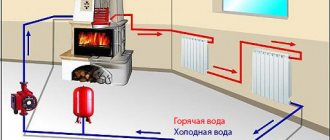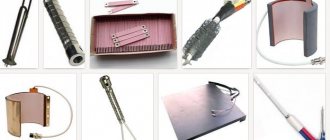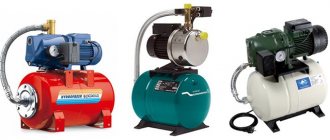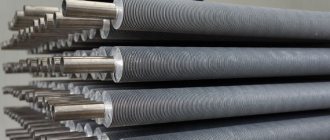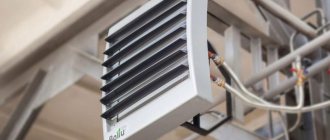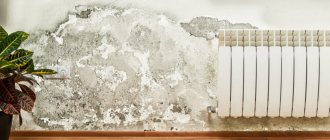What are
Heating devices are classified according to the following criteria:
- Coolant type. It can be liquid or gaseous.
- Manufacturing material.
- Specifications. This refers to the size, power, installation features and the presence of controlled heating.
When choosing the best option, it is necessary to build on the features of the home heating system and operating conditions. In this case, the entire list of requirements and standards regarding heating devices must be observed. Along with the power of the products, the specificity of their installation is of great importance. In the absence of gas supply and the possibility of arranging water heating, there is still an option with electric heaters.
How to choose
When installing a water heated floor under a laminate, you should take care of additional heating of living quarters with radiators. When choosing batteries for a country house, the following factors are taken into account:
- boiler power;
- type of fuel used;
- the level of automation of the installed equipment;
- radiator material;
- overall dimensions of the device;
- cost.
A high-quality battery must have high durability, resistance to corrosion and water hammer, and withstand high pressure. The destruction of metal occurs when the walls of the device are in direct contact with atmospheric air. The installation of an expansion tank in a closed heating system will help prevent this. In addition to these requirements, heating devices must comply with sanitary and hygienic standards and have an attractive appearance. For assistance in choosing and installing radiators, call + 7-926-966-78-68
Water heating system device
Hot water heating is the most common way to heat buildings. This explains the availability on the market of a significant variety of varieties of heating devices for water circuits. The reasons lie in the good level of efficiency of these products, as well as the reasonable costs of purchasing, installing and operating the service. The designs of these heating devices are very similar to each other. The core of each of them is a cavity: hot water circulates through it, heating the surface of the battery. Further, the convection process comes into play, transmitting heat to the entire room.
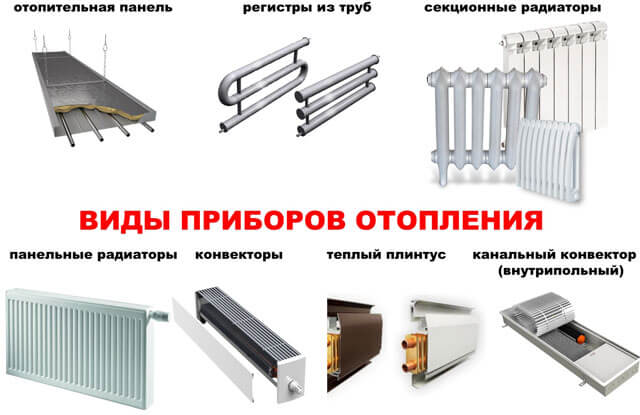
Radiators for water heating systems can be made of the following materials:
- Cast iron.
- Become.
- Aluminum.
- Combinations of materials (so-called "bimetallic batteries").
Any of these types of heating devices has its own specifics. In each specific case, it is necessary to take into account the area of the heated room, the installation features, the quality and type of heat carrier used (for example, in some cases, antifreeze is used). To regulate the power of the batteries, the possibility of building or detaching the sections is provided. It is desirable that the length of one radiator does not exceed 1.5-2 meters.
Combined hot water boilers
It is clear that a heat generator operating on one type of fuel, for example gas, is preferable. But different situations are possible, the way out of which will be the purchase of a combined boiler, in which a replaceable burner is installed, which can work both on gas and on diesel fuel.
However, this type of water heating devices also has its own nuances, in particular:
- such a heat generator will cost a little more than a boiler designed for one type of fuel;
- its efficiency is about 10-20% lower than that of a gas or oil-fired boiler;
- since the boiler is a large-sized unit, a separate room will have to be allocated for it;
- some of its components (fuel pump, blower fan, etc.) are powered by the electrical network. Prolonged winter power outages can result in pipeline ruptures. For such situations, you need to buy a powerful electric generator.
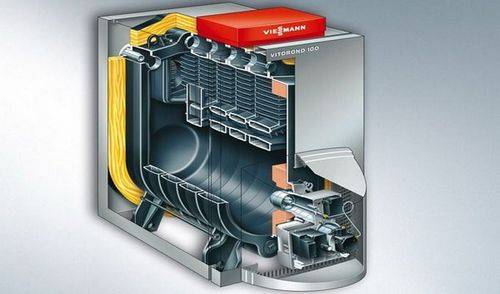

The heating boiler must have a certain power, and it must exceed the heat loss of the house by about 15-20%, which you still need to be able to calculate. For reinsurance, you can buy a more powerful unit (the price of the equipment also depends on this parameter), but then it is possible that part of its heat output will not be used, that is, in fact, the money will be wasted. If you buy a less powerful boiler, then you can freeze all winter, even if it works at full strength. Thus, it is best to seek the advice of a specialist.
In models of boilers of previous generations, a decrease in power entailed a decrease in efficiency. Modern equipment is equipped with several power levels, due to which it is possible to reduce the heat output of the unit and the amount of fuel, and this will not result in heat losses. The newest invention is hot water boilers with modeling heads, in which the stepless power reduction does not affect the efficiency of the equipment in any way.
Heating can be combined with a hot water supply system, for which it is enough to install a double-circuit hot water boiler. They are of various types - instantaneous, storage or in combination with a boiler.
To transfer heat from the coolant to the air, heating devices are used, without which the efficiency of the water heating system would be extremely low. Due to the special design of heating devices, you can extract the maximum amount of heat from the coolant.
Cast iron batteries
The cast-iron type of heating devices is one of the most common options for completing domestic centralized systems. It was preferred to other varieties mainly due to its cheapness. In the future, devices of this type began to be gradually replaced by devices with a higher heat transfer coefficient (for cast-iron batteries, it is only 40%). Currently, cast iron radiators are mainly equipped with old-style systems. As for modern interiors, you can find designer cast-iron models in them.
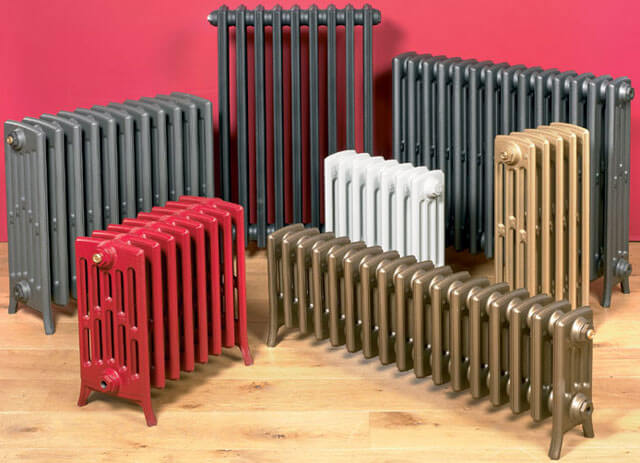

The strengths of the device of heating devices include a significant surface area through which energy is transferred from the coolant to the surrounding space. Another noticeable advantage is the durability of cast iron batteries: they can serve without problems for 50 years or more. There are also disadvantages, and there are many of them. Firstly, the coolant is used in very large volumes (up to 1.5 liters for each section). Cast iron is heated slowly, so you have to wait until after turning on the boiler heat begins to flow into the rooms. These batteries are not easy to repair and have to be cleaned every 2-3 years to minimize the likelihood of breakdowns. Installation work is complicated by the large weight of the radiators.
Bimetallic batteries
The strong point of bimetallic structures is special convection panels, which help to increase the quality of air circulation. In addition, devices of this type can be equipped with special regulators, with which you can increase or decrease the flow rate of the coolant. Installation work in its simplicity resembles the installation of aluminum radiators. Each of the sections has a power of 180 W, providing heating for 1.5 m2 of area.
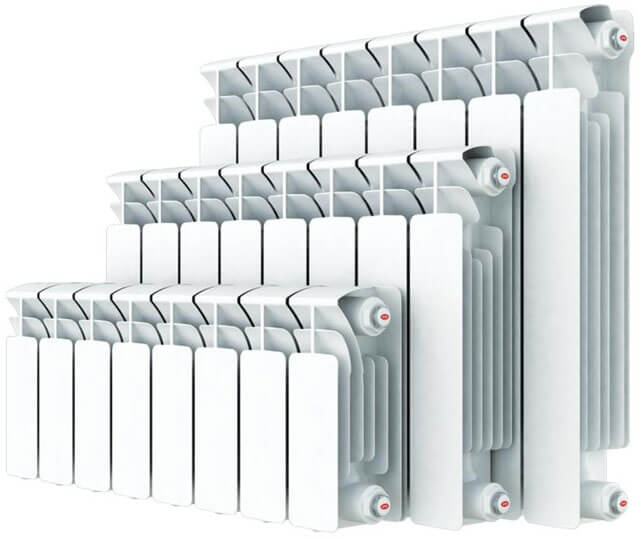

In some cases, the use of water-type heating appliances is encountered with serious difficulties. For example, bimetallic radiators cannot be installed in systems where antifreeze is used as a coolant. These non-freezing liquids, which protect pipes from freezing, can have a destructive effect on the inside of the batteries. You should also take into account the high cost of this heating option.
Bimetal and steel radiators
Many users say that it is better to use bimetallic or steel batteries instead of cast iron counterparts in the heating system. This choice can be explained by the small volume of the coolant inside the device. Efficient heating operation can be achieved even when installing a gas boiler in a private house.
The main advantages of the devices under consideration are:
- The presence of convection elements, which improves the circulation of heated air;
- Possibility of installing thermostats to regulate the temperature in each room.
- Simple device installation and affordable cost. Despite this, the installation of bimetallic radiators must be carried out by a master plumber.
Advice! When buying a metal battery, check with the seller if it can be disassembled and additional sections installed. This will help to select the power of the device for a specific room (if it turns out that there is not enough heating).
Electric types of heaters
In cases where problems arise with the organization of water heating, it is customary to use electric heaters. They are also presented in several varieties, differing from each other in power and method of heat transfer. The most significant disadvantage of household heating appliances of this kind is the high cost of consumed electricity. In this case, it is often required to lay new wiring, designed for increased loads. If the total power of all electric heaters exceeds 12 kW, technical standards provide for the organization of a network with a voltage of 380 V.
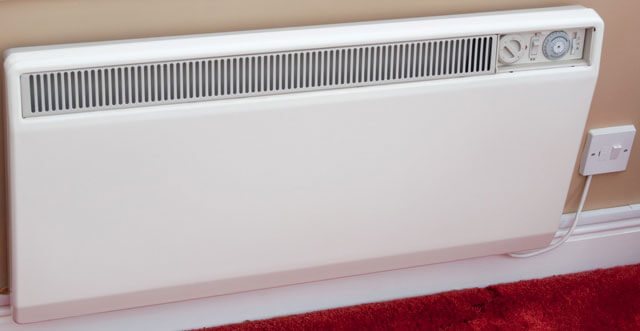

Electric heating devices
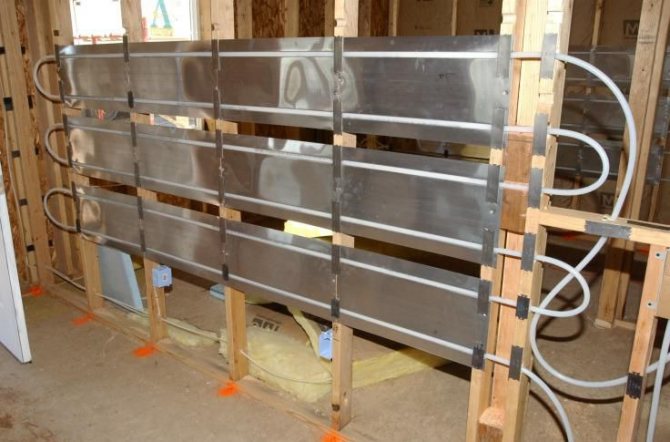

An example of electric heating in a prefabricated house
If the installation of a full-fledged water heat supply is impractical or impossible, electric heating devices are mounted for heating. They differ from the traditional ones in autonomy and compactness. In addition, there are several types of electrical appliances, which have a different principle of generating heat. The main disadvantage of electric heating is high energy costs. To minimize this, modern metering devices for heating are needed - multi-tariff electricity meters. In the evening and at night, there are preferential tariffs for electricity consumption.
The electrical wiring in the house must be adapted to the maximum loads from electric heaters for heating.
Heating convectors
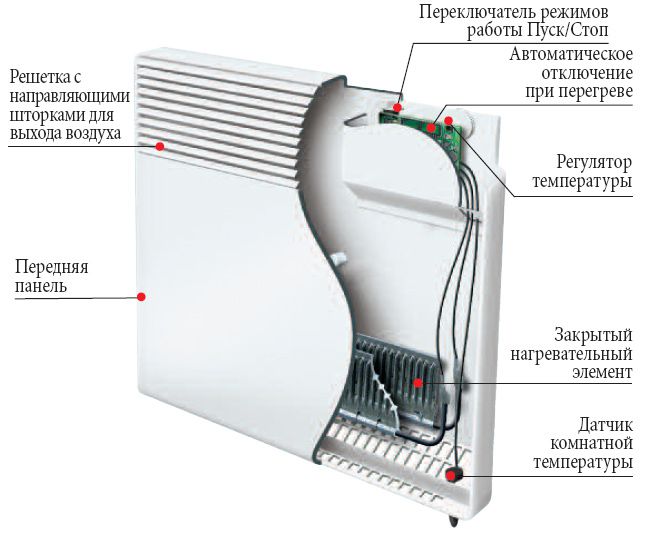

Electric convector
If the house or apartment does not have autonomous (centralized) heating, electric heating devices are most often installed. Outwardly, they are similar to standard radiators, but they have significant differences in design.
Almost all electrical heating devices are used as heating elements for heating elements. Inside is an element with a high electrical resistance. When a current passes through it, electrical energy is converted into heat. For greater efficiency, the heating elements are connected to heat exchange plates made of steel or aluminum alloy.
There are several types of electric home heating appliances:
- Convection... The design is designed for a relatively rapid heating of air in the room due to the movement of flows through special slots located at the top and bottom of the structure;
- Oil... To increase the area of the hot surface, the inside of the radiator is filled with a liquid with a high energy content.The temperature rise is much slower than that described above. However, even after switching off the electric heater, its surface remains hot for some time.
Almost all models are equipped with modern control systems. An obligatory element is an electronic thermostat, which has a temperature sensor for automatic regulation of the convector heating. Also, the safety of operation was not ignored. When the appliance is tipped over, the circuit breaker is activated. There are special models of heating radiators designed to work in wet areas - bathrooms, kitchens. They have a moisture resistant housing.
| Model | power, kWt | price, rub. |
| COOPER & HUNTER CH-2000 EC | 2 | 3495 |
| NEOCLIMA COMFORTE 2.0 | 2 | 2273 |
| OLMO OL 1000 M | 1 | 1932 |
| NOIROT Spot E-3 1500 | 1,5 | 5838 |
However, to supply heat to a large house, it is impractical to install electric convector heating radiators due to the high consumption of electricity. In this case, it is best to install more economical heating PLEN or IR heaters.
If the total power of the electric convectors exceeds 9 kW, you will need to connect a three-phase power supply with a voltage of 380 V.
Infrared home heating
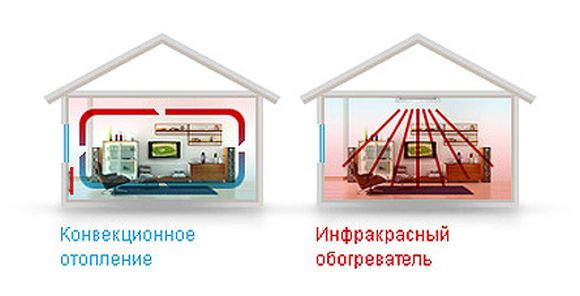

The advantages of IR heating
To increase the efficiency of maintaining a comfortable temperature in the room, electric heating devices are installed that emit heat waves in the infrared range. Their principle of operation is not to heat the air, but the surface of objects that have fallen into the zone of action.
The undoubted advantage of this technique is the reduction in power supply costs. This is due to the fact that the consumption of IR heaters is 20-30% less than that of similar models with heating elements.
Currently, there are 2 types of heating devices in the heating system, operating in the infrared range:
- Film heaters... Resistor conductors are applied on the surface of the polymer film, which emit infrared waves when an electric current passes through them. They can be mounted both as a warm floor and on the ceiling of a room - PLEN;
- Carbon heaters... A carbon spiral is placed in a special sealed glass flask. When the device is turned on, it generates infrared waves that heat objects. For efficiency, such devices are equipped with a reflector made of stainless metal or aluminum.
It is noteworthy that the latter type of room heating devices can be installed anywhere in the room. They are often used to maintain a normal temperature outside the home in a specific area.
| Model | power, kWt | price, rub. |
| UFO Star 1800 | 1,8 | 4090 |
| RUNWIN LONDON | 3 | 17150 |
| IR film Luchi, m2 | 216 | 1008 |
| IR film MONOCRYSTAL 220L ENP-E, m² | 135 | 673 |
However, for these IR heating devices for a private house, there are a number of application restrictions. First of all, do not cover the surface of the film. This can lead to overheating and damage.
The further the infrared emitter is located, the wider its coverage area. But this increases the degree of heat dissipation.
Oil radiators
The principle of convection is also used in the operation of oil electric heaters. Special oil is poured into the apparatus for heating with a heating element. To control heating, a thermostat is often used, which turns off the power when the desired temperature mark is reached. Oil-powered devices are characterized by high inertia. This is manifested in a slow warming up of the device and in the same slow cooling down after a power outage.
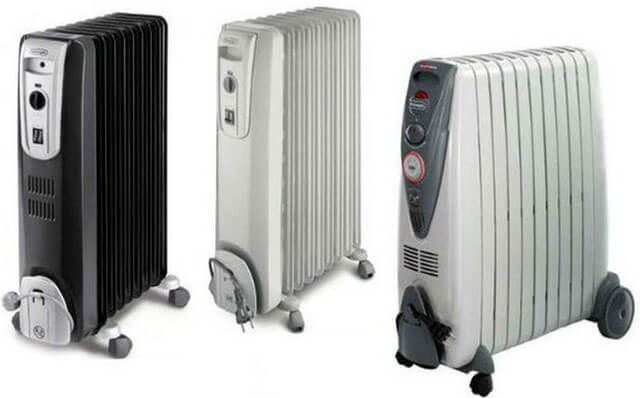

The surface temperature usually heats up to 110-150 degrees, which provides for the observance of safety rules. Such a device must not be installed close to flammable surfaces.Oil radiators are equipped with convenient regulation of the heating intensity, designed for 2-4 operating modes. Keeping in mind the power of one section (150–250 kW), it is not at all difficult to choose the optimal model for heating a particular room. The maximum power of such a device is limited to 4.5 kW.
Oil-cooled radiators
The appearance and principle of operation of such devices is completely similar to ordinary heating batteries. Only they are filled with mineral oil, and electric heating elements installed directly inside the inner cavity of the device heat it. They are successfully used in offices and residential premises. There are oil coolers open and closed. The ribs of the latter are protected by a metal casing. The main advantage of these devices is that they do not burn out oxygen in the room and do not heat up to temperatures that are dangerous for small children. Especially the latter property applies to closed radiators.
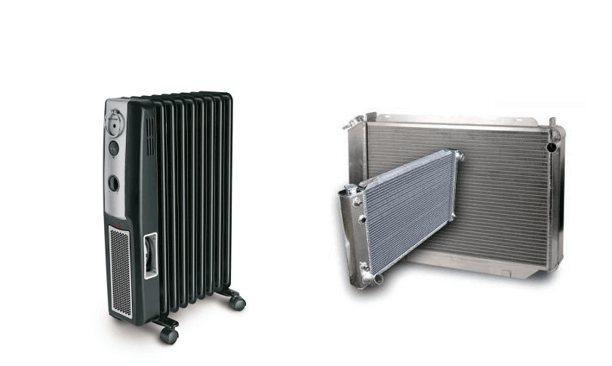

Open and closed oil coolers
Infrared heating
The choice of infrared heaters brings the following dividends:
- Energy savings of up to 30% when compared with conventional electrical appliances.
- Oxygen in the air does not burn.
- The room heats up in a matter of minutes.
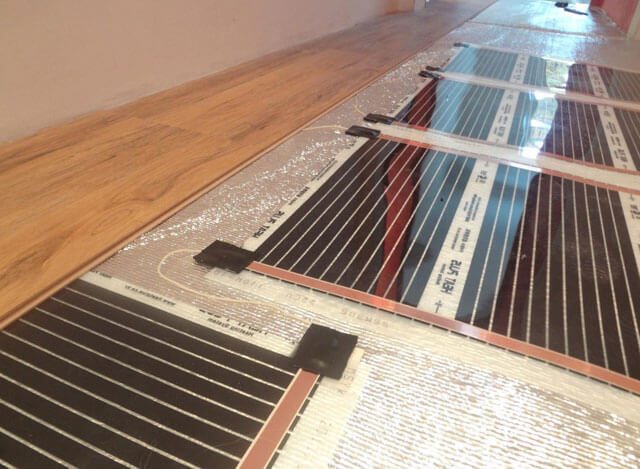

Infrared devices are classified according to the method of wave transmission. In new heating devices, radiation is transmitted to the surrounding space thanks to resistor conductors installed on a special film. The power of warm mats can be up to 800 W / m2. Film heaters are convenient because they can be used to organize warm floors.
As for carbon emitters, waves are emitted in them in spirals from a sealed transparent bulb. The power of such devices is in the range of 0.7-4.0 kW. The power of carbon heaters is an order of magnitude higher, which provides for more stringent fire safety measures.
Gas heating
In order to save money, you can use gas heaters. Their simplest type is a gas convector, which is switched to a main gas pipeline or a LPG cylinder. The burner of the device is completely protected from contact with the surrounding atmosphere: in this case, a special tube is used to supply oxygen, which is led out into the street through a hole in the wall. These devices are characterized by high power (at least 8 kW) and low cost of operation. Among the weaknesses of gas heaters, one can single out the obligation to register with regulatory agencies, the need for effective ventilation and the need for regular cleaning of the nozzles.

